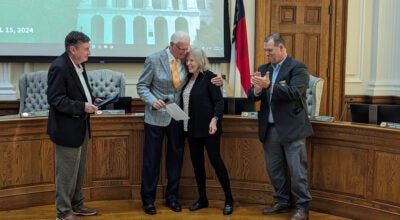Detectives take aim at unsolved homicides
Published 12:00 am Sunday, December 2, 2012
SALISBURY — After walking down a narrow hallway deep into Rowan Regional Medical Center, Andrea Ellis Polk could barely make it through the doorway of a room lined with metal drawers.
She didn’t need to, Polk said. She could identify her son from the morgue’s entrance.
“That’s a walk I’ll never forget,” she said. “To see them open that drawer, and they pull it out. He was in a white body bag.”
It was February 2001. A few hours earlier, Polk had been asleep on a sofa in her Granite Quarry living room.
She isn’t sure what woke her, but she vividly recalls the moments after — when State Bureau of Investigation agents told her they had found her son, Marlon Darnell Ellis, partially buried in brush in a Spencer yard off Five Row Road.
He had been shot multiple times in the upper body and head.
Marlon Ellis’ murder didn’t hit his mother immediately. But the following days were nearly unbearable.
“For a parent to have to go through a tragedy of losing a child by somebody else’s hand,” Polk said. “I don’t wish that on my worst enemy.”
After 10 years, Polk said, the pain is still strong.
A simple phone call in August from Chief Deputy David Ramsey of the Rowan County Sheriff’s Office brought her to her knees.
“Ramsey said we’re reopening the case,”?Polk said. “I just broke down and cried. I got silent, and he said, ‘Hello.’ And I said, ‘I’m here. You’ll have to excuse me.’ ”
Murders revisited
The Ellis murder is one of 13 unsolved homicides chosen so far for reinvestigation by Lt. Chad Moose, head of the Sheriff’s Office Criminal Investigation Division. Files for the cases have been pulled out of storage and are being reviewed and retooled into thinner notebooks with streamlined narratives.
The goal, Moose said, is to break down each case and go through the evidence as if it were new.
“I take them home over the weekend and read them, front to back,”?Moose said.
“… You go through the case file and try to look at the basics: What’s the motive? The means? A lot of it is already there for you in the case file — you maybe try to see if there’s a different motive you can explore.”
Detectives hope the cold case campaign can bring closure for the unsolved murders, some dating back nearly 40 years. In some cases, investigators have even discussed bringing in retired detectives and former prosecutors to give each case fresh perspective.
Despite extensive history as a crime scene investigator in Rowan, Moose has had direct contact with only a few of the cases. The same goes for Sheriff Kevin Auten. But neither was assigned as an investigator for the unsolved 13.
Surrounded by boxes of files stuffed into Moose’s office on a recent morning, the two leafed through case after case, pointing out details and dead ends.
“I took the missing person’s report in that one,” Auten said, looking through a file. “You go back and think, ‘Did I do enough that day? Could I have changed anything that happened?’”
Issues with evidence
In many of the cases, poor reports and a lack of evidence hinder investigators’ efforts.
“We take so much more evidence now,” Moose said. “The average murder, we take about 200 items.”
The difference, he said, is that investigators now carefully collect and store evidence with the hope that if they can’t solve the case, someone after them can.
In a recent homicide, investigators filled an entire bookshelf with folders of reports, crime scene details and witnesses statements.
Moose said he still has the vehicle involved in the murder.
Crime scene investigations today, he said, are starkly different than 40 years ago when master case files oftentimes didn’t even have the actual files inside.
Vague reports have also slowed progress.
The front page of an initial report taken from a case in the 1970s simply reads, “Body found in ditch.”
Not surprisingly, those murders in the ’70s and early ’80s provide investigators with some of the fewest leads, Moose said.
The oldest reopened case, the 1978 murder of Herbert Hoover Moss, contains some of the biggest obstacles.
Moss was shot in the head with shotgun during an apparent robbery at a North Kannapolis convenience store. The store no longer exists and the file didn’t include a photo of Moss.
Similarly, in 1980, John Williams’ body was found in a field off Miller Road.
He had been beaten to death with an object authorities couldn’t immediately identify. Moose said Williams’ 32-year-old case file could fit into a box typically a fraction the size of current investigations.
But detectives have been able to make a new development in the case.
“We actually got a DNA profile of the suspect in that one,” Moose said.
The sample was submitted to a national DNA database, but no matches have been found.
‘Another shot’
Neither evidence nor solvability factored into the 13 chosen, Moose said.
“Some of them — where they body is dumped on the side of the road — there’s very little evidence,” he said. “But we still want to give it another shot.”
The cases that were chosen do have quality evidence that can be reexamined by detectives — a problem detectives saw in other cases.
In the mid 1900s, officers placed evidence into paper bags and later plastic bags. Evidence in many of those cases has deteriorated.
Authorities have moved much of the older evidence into standard storage boxes and sealed them.
As Moose continues to reexamine cases, he said, he also hopes to recruit help. Deputies hope they can convince a recently retired detective from Kannapolis Police and another from Salisbury to assist in the cold case investigations.
Retired District Attorney Bill Kenerly is another ideal eye for the files, Auten said, but when interviewed he hadn’t yet contacted Kenerly about the idea.
“You just get a truly unbiased, no opinion,” Auten said, when bringing in an outside agency to look at a case. “You’ve got to be careful not to just look at one person until you have a reason to just look at one person. Sometimes detectives can get tunnel vision.”
A large part of the reason for wanting assistance is simply that agencies don’t always have the manpower to comb through old murders. As new crimes happen, detectives are forced to drop cold case investigations and focus on searching for, arresting and prosecuting offenders.
In cases like Sherry Mash and Jean Waley, separate murders where the bodies of both women were found in Rowan County fields, deputies have returned time and time again to the recorded timelines and tedious details around the victims.
The most recent case on the 13 chosen for reopening is the 2010 murder of Deyanira “Dee” Rios de la Cruz.
The 20-year-old cashier was shot and killed just after hitting the panic button during a morning shift at Latin Mix in Spencer.
Technology gives hope
Andrea Polk doesn’t drive near the road where her son was killed. His grave is painful enough, she said.
When Ramsey told her about the new investigations, she said, she didn’t tell her grandchildren.
“We refuse to let them know what’s going on until we get some final answers,” she said.
As she waits, Polk said, she keeps up with investigations — especially as old ones are solved.
Changes in technology give her hope, she said.
Detectives are resubmitting evidence in several cases to the SBI lab for blood and fingerprint analysis. Evidence in other cases was submitted for the first time.
Moose said DNA?analysis has changed over the years. Along with more advanced software, forensic experts can multiply small DNA samples for more accurate testing.
Anytime detectives are actively looking at your case, Polk said, there’s hope.
She hopes for the chance to finally tell her family it’s over. Until then, she asks anyone with information to call detectives.
“These children are still wondering,” she said. “My family is still wondering.”
Contact reporter Nathan Hardin at 704-797-4246.




